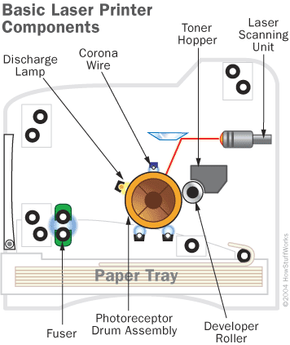The Basics: Drum
Initially, the drum is given a total positive charge by the charge corona wire, a wire with an electrical current running through it. (Some printers use a charged roller instead of a corona wire, but the principle is the same.) As the drum revolves, the printer shines a tiny laser beam across the surface to discharge certain points. In this way, the laser "draws" the letters and images to be printed as a pattern of electrical charges -- an electrostatic image. The system can also work with the charges reversed -- that is, a positive electrostatic image on a negative background.
After the pattern is set, the printer coats the drum with positively charged toner -- a fine, black powder. Since it has a positive charge, the toner clings to the negative discharged areas of the drum, but not to the positively charged "background." This is something like writing on a soda can with glue and then rolling it over some flour: The flour only sticks to the glue-coated part of the can, so you end up with a message written in powder.
Advertisement
With the powder pattern affixed, the drum rolls over a sheet of paper, which is moving along a belt below. Before the paper rolls under the drum, it is given a negative charge by the transfer corona wire (charged roller). This charge is stronger than the negative charge of the electrostatic image, so the paper can pull the toner powder away. Since it is moving at the same speed as the drum, the paper picks up the image pattern exactly. To keep the paper from clinging to the drum, it is discharged by the detac corona wire immediately after picking up the toner.
